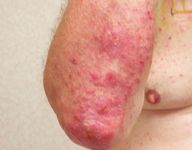- General Dermatology
- Eczema
- Chronic Hand Eczema
- Alopecia
- Aesthetics
- Vitiligo
- COVID-19
- Actinic Keratosis
- Precision Medicine and Biologics
- Rare Disease
- Wound Care
- Rosacea
- Psoriasis
- Psoriatic Arthritis
- Atopic Dermatitis
- Melasma
- NP and PA
- Skin Cancer
- Hidradenitis Suppurativa
- Drug Watch
- Pigmentary Disorders
- Acne
- Pediatric Dermatology
- Practice Management
- Prurigo Nodularis
Article
Topical antibiotics: Routine use can boost risk of allergic contact dermatitis
Author(s):
Dermatologists have been trained to squeeze topical antibiotics on the simplest of cuts and excisions. Because of allergic reactions and considering the efficacy of an alternative - plain petroleum jelly - dermatologists must revamp their thinking.

Key Points

Risks
An expert in immunology and skin allergies, Dr. Gaspari says there are two primary risks. First and most common, a patient may develop allergic contact dermatitis (ACD), presenting with itching, redness and scaling.
Type I hypersensitivity is more rare. In its most benign form, the allergy manifests immediately in hives and swelling.

The risk of an allergic reaction is much higher in patients with chronic conditions, such as leg ulcers and eczema.
"Impaired skin integrity and barrier function leads to easier drug penetration," Dr. Gaspari tells Dermatology Times.
Prevalence rate
The prevalence of ACD due to topical antibiotic use in the general population is unknown. Most of what we do know comes from data collected by 13 referral patch test clinics in the United States and Canada.

In most reporting periods, neomycin was the second most common allergen of all tested substances, not just topical antibiotics.
Patch-test sensitivity to bacitracin ranged from 1.5 to 9.1 percent; it ranked between No. 6 and No. 10 on the list of most common allergens.
Literature review
Erin Warshaw, M.D., M.S., associate professor of dermatology at the University of Minnesota, Minneapolis, recently published a literature review of the incidence rate of allergic reactions to topical antibiotics (J Am Acad Dermatol. 2008;58:1-21).
Using studies dating back to 1972, she and co-author, Kathryn A. Gehrig, M.D., calculated the pooled average sensitization rates for special populations.
For venous insufficiency (total patient population of 2,631), the sensitization rate in published case studies was 67.2 percent. Bacitracin sensitivity was 19.7 percent; framycetin, 16.0 percent; and neomycin, 15.8 percent.
Other antibiotic creams evaluated - gentamicin, chloramphenicol, polymyxin B, oxytetracycline - had lower, but significant, sensitivity rates.
For chronic otitis extrema (total patient population of 388), the overall sensitivity rate was 29 percent. Framycetin sensitivity was 15.6 percent; neomycin, 15.4 percent; and gentamicin, 7.1 percent.
For other chronic eczematous conditions, the paper stated, the reported prevalence of sensitization to any antigen in chronic eczematous conditions excluding stasis dermatitis (seborrheic, atopic and nummular) ranges from 37 percent to 55 percent in a total of 3,469 patients with eczematous dermatitis.
The most common sensitizers in this population are neomycin and chloramphenicol.
Dr. Warshaw's primary concern is bacitracin. "Dermatologists need to remove it from their offices, because it's a common sensitizer and because there have been reports of immediate anaphylaxis in dermatology clinics," she says.





